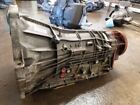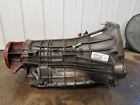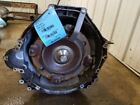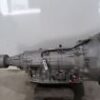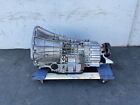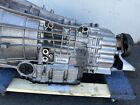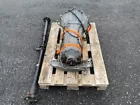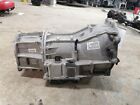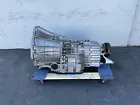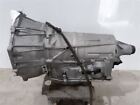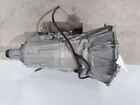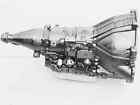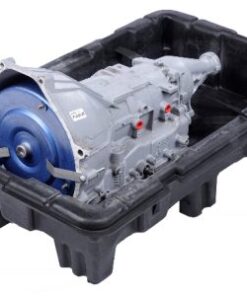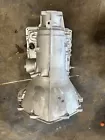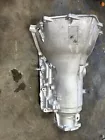The 10R80 10-speed automatic transmission developed in collaboration between Ford and General Motors, with each company producing its own version Ford’s is the 10R80 10-speed automatic transmission, GM’s counterpart is the 10L80. Though jointly engineered, each special-cases the transmission to their vehicle architectures and shift calibrations.
Production began in 2017 at Ford’s Livonia Transmission Plant in Michigan, later expanding to the Sharonville facility in 2018. GM produces its version at Romulus, Michigan, and since 2018, also at Silao, Mexico.
Design & Engineering Features
Compact Yet Efficient Packaging
Despite offering ten forward gears, the 10R80 10-speed automatic transmission is only ~1 inch longer and about 4 lbs heavier than the outgoing six-speed 6R80. A redesign of the torque converter—making it 0.4 inches thinner and 2 lbs lighter—and the use of lightweight materials (aluminum, high-strength steel, composites) eliminate any cast-iron parts, cutting down bulk.
Planetary Gearsets & Clutch Design 10R80 10-speed automatic transmission
The transmission uses a dual-planetary gearset system managed by six clutches. A notable innovation involves a triple-clutch assembly on an intermediate shaft, optimizing space while enabling quick gear transitions.
Hydraulic Systems & Fluid Friction Reduction On 10R80 10-speed automatic transmission
Two hydraulic pumps serve the clamps:
-
Primary pump: off-axis with variable displacement—efficient and compact.
-
Secondary pump: electric, enabling “start-stop” features with minimal delay.
Friction is minimized using roller-type thrust washers and clutch plates kept apart by tiny springs. These design elements optimize efficiency in each gear.
Gear Ratios & Performance Spread
The 10R80 10-speed automatic transmission doesn’t possess an extraordinarily wide overall ratio spread (~7.4). The benefit lies in tight individual gear spacing, with an average RPM drop at ~20%, compared to 25% typical in ZF’s eight-speeds. This precision aids smooth performance, efficient towing, and improved fuel economy.
Overdrive Focus
-
1st: 4.696:1
-
8th: 0.854:1
-
9th: 0.689:1
-
10th: 0.636:1 (deep overdrive)
The top three gears are close-knit, allowing the transmission to stay in 10th over varied highway speeds, with imperceptible 10‑9 downshifts when needed.
Control Electronics
Shift operations rely on six linear force solenoids, each corresponding to a clutch. These solenoids control hydraulic pressure directly via armatures—more precise than fluid-based actuation. A failure in their power circuit results in no clutch engagement, meaning no fail-safe shifting.
Fluid, Service, and Thermal Management Of 10R80 10-speed automatic transmission
Transmission Fluid
The validated fluid is Mercon ULV – ultra-low viscosity, around 4.5 centistokes—thinner than previous-generation fluids to reduce friction and aid fuel efficiency. Introduced in 2014, it’s co-developed by Ford and GM and is not backward compatible.
Fluid Capacity & Maintenance
The typical fluid capacity is around 13 U.S. quarts, serviced using filter part Motorcraft FT202 and Motorcraft XT‑12‑QULV fluid. Recommended fluid and filter replacement interval is 150,000 miles.
Thermal Bypass and Warm-up
An internal thermal bypass expedites warm-up to operating temperature, improving efficiency. The compact hydraulic system and optimized components work to heat and regulate oil temperature swiftly.
Driving Behavior & Shift Logic
-
Skip Shifts: Normal behavior—under heavy throttle or light pedal, the transmission can skip gears (known as double-step), maximizing acceleration or efficiency depending on conditions.
-
Driving Modes: “Normal,” “Tow/Haul,” and “Sport” alter shift aggressiveness and behavior—adaptive learning continually adjusts shift timing based on driving style.
Known Issues & Customer Feedback
Service Bulletins & Recalls
-
TSB 18‑2079: Addresses harsh or delayed shifts and DTC P0711; fix via PCM reprogramming.
-
TSB 18‑2160: Tackles TCC valve sticking with code P0741/P1744; fix by valve body assembly replacement.
-
Recall 18S09 / 18V213000: Due to a missing roll pin that may disable Park, causing roll‑away risk; owners were notified starting April 2018.
Common Failures
-
Harsh, delayed, or erratic shifts: Often addressed by software updates or valve body replacements.
-
Pump drive gear failures: Especially in diesel applications, leading to erratic shifts or power loss.
-
Leaks: Caused by high operating temps, gasket failures, pan warping, or case cracks—common sources around the transmission pan.
-
Torque converter shudder: Especially during lock-up between ~30–45 mph.
-
CDF drum bushing issues: Early units (before August 2023) had CDF drum bushings that slipped, causing catastrophic failure. Ford implemented improved bushing designs and hardened shells as fixes.
Lawsuits 10R80 10-speed automatic transmission
Multiple class-action lawsuits—one in Illinois—cite harsh shifts, hesitation, loss of power, and claims Ford ignored known faults. Included vehicles: 2019–2022 Rangers, 2018–2021 Expeditions, 2018–2022 Mustangs, 2018–2021 Lincoln Navigators, 2021 F‑150. At least one suit remains ongoing as of October 2023.
Real-world Owner Experience
Reddit users offer candid insights:
Other users report expensive repairs—for instance, replacing a faulty CDF drum and bushing in a 2018 F‑150 at 85K miles cost ~$9,600.
Many caution that unless repaired with updated parts, the odds of failure remain high post-warranty.
Summary Table
| Area | Summary |
|---|---|
| Design & Efficiency | Compact, lightweight, precise gear steps, modern hydraulic & electronic control |
| Fluid & Thermal | Uses Mercon ULV, efficient warm-up, 150K-mile service intervals |
| Shift Logic | Adaptive learning, gear-skipping, multiple driving modes |
| Failures & Remedies | Common issues with shifts, leaks, valve body, CDF drum; TSBs and recalls available |
| User Feedback | Mixed—some report flawless operation; others face expensive repairs; many deferred until warranty expiration |
Closing Thoughts
The 10R80 10-speed automatic transmission represents a significant leap in automatic transmission design: turbo-efficient, compact, and smooth when functioning as intended. Its intricate build—dual planetary sets, hydraulic optimization, electronic control—enabled broad gear ranges and performance benefits.
However, its complexity also introduced failure points. From valve body issues to CDF drum defects, many of these problems were mitigated in design updates or addressed via recalls and service bulletins. Still, countless owners continue to report costly repairs and inconsistent shift behavior.
If you own (or plan to own) a vehicle with the 10R80 10-speed automatic transmission, key action items include:
-
Stay updated with TSBs and recall notices
-
Replace outdated components with updated parts when needed
-
Consider maintenance—use Mercon ULV fluid at proper intervals
-
Advocate for warranty coverage, especially with pre-2023 models
-
Get dealer validation of repairs, if issues arise
Want to dig deeper? I can help with torque converter diagrams, shift strategies, repair walkthroughs, or comparisons to other transmissions. Just say the word!


